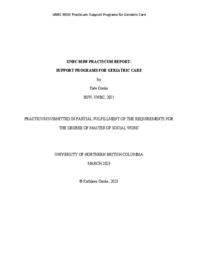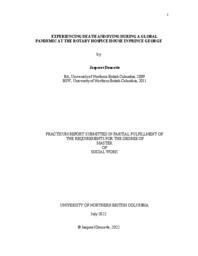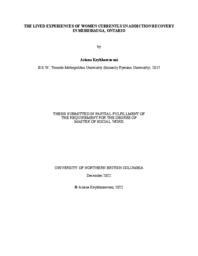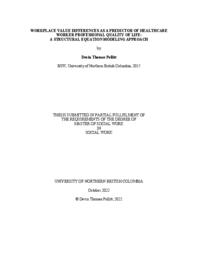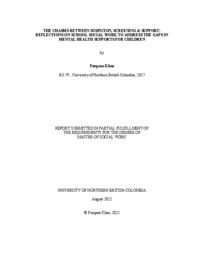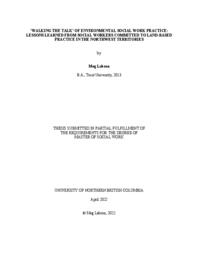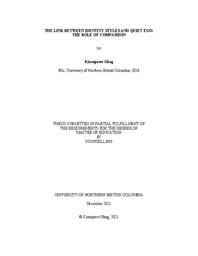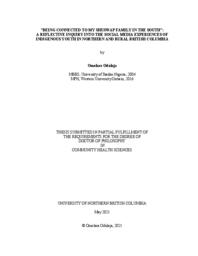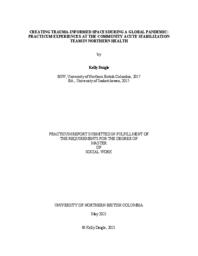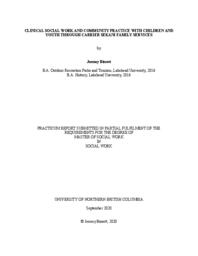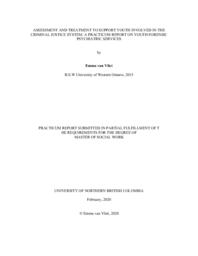Burke, Susan
Person Preferred Name
Susan Burke
Related Works
Content type
Digital Document
Description / Synopsis
No synopsis available
Origin Information
Content type
Digital Document
Origin Information
Content type
Digital Document
Origin Information
Content type
Digital Document
Origin Information
Content type
Digital Document
Description / Synopsis
Scholars have been calling for the integration of the natural environment within social work for over thirty years. However, the literature provides little insight into youth perspectives on their relationships with land and place, particularly in rural and remote communities. In fall 2022, I interviewed twelve students ages 14-17 at Fort St James Secondary School in BC’s Nechako Lakes District (School District 91) about their experiences spending time outdoors. By student choice, half of these interviews took place inside their school and half took place in outdoor settings nearby the school. Through reflexive thematic analysis, I developed five themes from our interviews, including (1) Specificity in relationships: Where we are (and who we are) matters; (2) Pathways to negotiating relationships with land and place; (3) Intersections of community, land, and youth resilience; (4) People are connected through place and time; and (5) Youth have agency and responsibility. My discussion links youth relationships with land and place to social work practice and highlights connections between the resilience of youth, their communities, and the land and water they rely on. This research contributes to a growing body of literature on social work and the environment and identifies future avenues for the integration of land and place within research.
Origin Information
Content type
Digital Document
Description / Synopsis
My practicum placement took place at Cottonwood Creek Wellness in Nelson, British Columbia where I began working alongside my practicum supervisor, Catherine Williams, who provides therapeutic support to families, children, and youth. Her services include offering specialized counselling in the areas of Attachment, working with parents, Family Therapy, Infant Mental Health, and assessment and treatment of all forms of Anxiety. My objective within my practicum was to practice from a holistic and trauma-informed perspective and to gain an understanding of how alternative therapies, such as yoga-based interventions can be incorporated into clinical social work practice. Not only did my experience as an MSW student provide me amples of opportunities to explore how to use complementary treatment modalities with clients, but it also allowed me to witness their efficacy when integrated into the therapeutic process in a purposeful, open, and creative manner.
Origin Information
Content type
Digital Document
Description / Synopsis
no abstract available
Origin Information
Content type
Digital Document
Description / Synopsis
This practicum report is a summary of my experience at the Prince George Rotary Hospice House and a reflection upon the death and dying process during a global pandemic. Aspects of my practicum report are explored via a literature review, time spent at Hospice House and self-reflection on my personal and professional framework. My experience at Hospice House provided me the opportunity to witness death and dying in a home-like environment with full supportive care where the focus was always the guest and family. During this practicum I had the opportunity to wholeheartedly connect with people as they transition into another phase of life while I also supporting families during this difficult time. A common theme that provided comfort to the hospice care team was that perhaps the dying person was transitioning into a beautiful world where their family and friends await their arrival. The knowledge I gained from this practicum will continue to support my professional practice in acute care, where death and dying are predominate. As I continue my social work journey I am reminded of being open-hearted, being present in the moment with people as they are in pain, and acknowledged that being a part of someone’s dying journey is an honour.
Origin Information
Content type
Digital Document
Description / Synopsis
This research explores women's experiences in recovery from addiction in a suburban area of Mississauga, Ontario (ON). In the suburbs drugs are not as localized as they might be in a city. The goal set out in this research was to better understand recovery from the women’s perspectives as well as identify barriers, challenges, and benefits they faced in recovery and treatment programs. The research offers suggestions on how this information could be considered when creating or adapting current recovery and treatment programs. The research may also help us understand and improve women’s entry, retention, and completion of treatment programs. Six participants participated in semi-structured interviews, four in person and two over the video platform Zoom due to the COVID-19 pandemic. Thematic analysis was conducted and four themes emerged: opinions on treatment programs, cravings and withdrawals, support, and recommendations to improve treatment programs.
Origin Information
Content type
Digital Document
Description / Synopsis
This MSW thesis explores workplace value differences as a predictor of healthcare worker professional quality of life. Secondary data analysis was performed on data previously collected on hospice and palliative care workers in a 2013 Pan-Canadian Study. The fit of a theoretically informed model to the dataset was analysed, exploring empirical support that healthcare worker value differences within the workplace accounts for a significant part of the variance in their levels professional quality of life. In the Pan-Canadian study, measures of professional quality of life included the Professional Quality of Life Scale (ProQoL). Additionally, the Nursing Unit Cultural Assessment Tool (NUCAT) was also used. This study reviews the pertinent literature, articulates the model suggested above by exploring existing evidence and theory, and tested the model fit using a structural equation model. Understanding the impact that workplace factors have on healthcare worker professional quality of life is an important area of research. Further research utilizing structural equation modeling may help increase our understanding of the multi-factorial nature of professional quality of life measures and its impact on workers, patients, and families.
Origin Information
Content type
Digital Document
Description / Synopsis
Children often slip through the cracks in the systems when they display disruptive behaviours in classrooms but have no mental health diagnoses. Without medical explanations for behaviours, which may or may not be warranted, students face suspensions or removal from schools possibly leading to poorer life outcomes. There can be as many reasons for disruptive behaviours – undiagnosed mental illnesses, childhood adversity, life transitions, and more – as there can be justifications for not diagnosing children at a young age: labeling, stigma, apprehension from parents, and so on. Often supports for students require them to have diagnoses. This report details my practicum experience within the Social Work Program in the Indigenous Education Department of School District #57 in Prince George, British Columbia (BC). It is an exploration of the role of Indigenous Social Workers as they navigate the myriad of situations they face when working with students who frequently display disruptive behaviours.
Origin Information
Content type
Digital Document
Description / Synopsis
The research presented in this thesis explored environmental social work; in particular, it responds to a gap in the literature regarding the lack of a clear practice model for social workers to follow, by focusing on how environmental social work is done. In order to offer an in-depth, qualitative look at what environmental social work can look like in practice and in specific places, I looked to self-identified social workers living and working in the Northwest Territories (NWT), Canada. The six social workers who responded to this call are all working in ways that integrate land, place, and the physical environment into their social work practice. Due to the impacts of the Covid-19 pandemic, the research was conducted entirely via distance using telephone, e-mail, and Zoom. Using a critical place inquiry approach and framed by theories of ecosystem approaches to health, grounded normativity, and relational validity, six in-depth interviews were conducted with social workers who shared their experiences of land-based practice in their personal and professional lives. Findings took the shape of five themes: ‘Lessons from the Land’, ‘Lessons in Ways of Being for Social Workers’, ‘Lessons from Being in Relationship’, ‘Lessons for our Workplaces and Profession’, and ‘Lessons in Practice’. The findings offer insight and practical examples for social workers seeking to connect their practice to the land; they also contribute practice wisdom to emerging discussions regarding both what can be done in environmental social work practice and how.
Origin Information
Content type
Digital Document
Description / Synopsis
Relationships between the identity styles (informational, normative, and diffuse-avoidant), compassionate love for humanity, self-compassion, and quiet ego were explored. To date, no research has examined relationships between these constructs. Three hundred four individuals (84 men and 220 women) completed self-report measures of identity style, compassionate love for humanity, self-compassion, and quiet ego. Participants were members of an age range referred to as emerging adults (ages 18 to 29). Seven hypotheses were investigated, including whether: (1) there will be a significant positive relationship between the informational identity style and quiet ego; (2) there will be a significant negative relationship between the normative identity style and quiet ego; (3) there will be a significant negative relationship between the diffuse-avoidant identity style and quiet ego; (4) the informational identity style positively predicts quiet ego, with high self-compassion being a mediating factor; (5) the informational identity style positively predicts quiet ego, with high compassionate love for humanity being a mediating factor; (6) the normative identity style negatively predicts quiet ego, with low compassionate love for humanity being a mediating factor; and (7) the diffuse-avoidant identity style negatively predicts quiet ego, with low self-compassion being a mediating factor. Data analyses were carried out using the statistical software SPSS to conduct correlations and hierarchical multiple regressions, in order to examine the hypotheses. Results indicated that quiet ego was significantly positively correlated with the informational identity style, and significantly negatively correlated with the normative and diffuse-avoidant identity styles. Furthermore, the positive relationship between the informational identity style and quiet ego was partially mediated by compassionate love for humanity. The negative relationship between the normative identity style and quiet ego was linearly impacted, but not mediated, by compassionate love for humanity. The negative relationship between the diffuse-avoidant identity style and quiet ego was linearly impacted, but not mediated, by self-compassion. Potential reasons for why the observed results were obtained are provided. Future studies may explore potential gender differences in these relationships, in addition to analyzing the different components of self-compassion, and their relationship to the identity styles and quiet ego. Limitations for this study included the use of a survey design, which reduces the ability to infer directionality from the findings. The implications of the results are discussed.
Origin Information
Content type
Digital Document
Description / Synopsis
In this report I discuss my practicum experience at Carrier Sekani Family Services and my work with the Child and Youth Mental Health Team during the summer of 2021. I review the agency I worked with, including an overview of the services they offer and its mission. My personal positioning and theoretical orientation are outlined, with a specific focus on how social location impacts my work, social constructivism, and strength-based framework. A literature review is provided in which four topics related to my practicum are reviewed: child and youth mental health, Indigenous child and youth mental health, the importance of providing services to children and youth, and practice considerations. I discuss my practicum learning experience and focus on the theme of holistic practice. Finally, I review how my practicum experience will impact my future practice and how my learning will benefit me and my future clients.
Origin Information
Content type
Digital Document
Description / Synopsis
Contextualizing clinical social work practice was the goal of the 450 practicum hours I completed at Walmsley and Validity Counselling Services. The practicum report starts with an overview of clinical social work practice and provides a detailed history of the practicum agency, services offered, and funding. In the following chapters, I explore and weave myself into the theoretical orientations that ground my practicum practice. Also, there is a salient review of literature necessary to contextualize clinical practice, especially in Northern British Columbia. From the practicum experience, I drew connections between the contextualization of clinical social work practice and key elements such as reflexivity, supervision, and training.
Origin Information
Content type
Digital Document
Description / Synopsis
This report focuses on the clinical social work skills and knowledge I gained during my Master of Social Work (MSW) practicum at the Warrior Support Centre in Mental Health Services with the 2 Field Ambulance unit at Garrison Petawawa in Petawawa, Ontario. My theoretical frameworks that guided my learning included General Systems Theory, Ecosystems Perspective, and Feminist Theory. My chosen methodology was discourse analysis to deepen my understanding and learning experiences. Literature on the Canadian Armed Forces (CAF), military social work, mental health, and stigma in the military informed my construction of knowledge and observations. This report outlines my overall learning goals and objectives in clinical social work practice supporting active military members. My experiences, observations, clinical skill development and subsequent practice implications are explored at length.
Origin Information
Content type
Digital Document
Description / Synopsis
The purpose of this report is to summarize my practicum experience with the Gitanmaax Men’s Group at the Gitanmaax Health and Wellness Centre in Gitanmaax Village, BC. The agency serves Gitanmaax membership living within the community of Gitanmaax village as well as those living off-reserve in the surrounding area. This report outlines the learning goals of my practicum and how those objectives were met through reflection, supervision, mentorship, and practice. Unforeseen learning came as a result of the COVID-19 pandemic and the impact it was having on the Gitxsan nation and on the transfer of cultural knowledge to the younger generation. Along with strengthening my social work skills, my practicum allowed me to explore rural ethics in social work and how these connect to practice. This account of what emerged from my practicum learning concludes with suggestions around ethics, self-care, service delivery, and one’s role as a non–First Nations person working in a First Nations community.
Origin Information
Content type
Digital Document
Description / Synopsis
This research extends and explores two key concepts. First, cultural preservation is important to Indigenous health and wellbeing. Second, when Indigenous youth spend quality time (whether online or offline) on issues pertaining to their identity and sense of self, that time can be key to preserving Indigenous cultures. This research project was an exploratory study carried out using a variety of research methods, including online surveys, semistructured interviews, and open ended storytelling engagements. In this study, youth ages 15 to 24 years interacted with one another in online and offline spaces, which in some cases served as culturally safe wellbeing sites where their self-esteem increased, especially if they were mentored by Indigenous peers and adults. This study found out that Indigenous youth are active social media users and engage in all kinds of activities including self presentation, social connections, cultural activities, and advocacy. The risks and benefits of using social media for identity expression and cultural engagement were identified, but some youth were noted to require supports to engage safely on social media to derive maximum benefits. The interdisciplinary nature of the research merges concepts, theories, and ideas from First Nations Studies, Sociology, Community Health, and Media Studies. This project embraced methodologies employed in these various disciplines but used a Two-Eyed Seeing framework as a tool to ensure cohesiveness in the research and respect for Indigenous cultures and cultural protocols. The research ultimately unfolded using lenses of both Indigenous and nonIndigenous worldviews, which I believe contributed greatly to the richness of the findings.
Origin Information
Content type
Digital Document
Description / Synopsis
During my social work practice with vulnerable populations, I have found that many clients and families I work with have experienced trauma in various forms. This is no less true in our current reality of concurrent health crisis: the opioid epidemic and the COVID-19 pandemic. My practicum at CAST provided me with numerous opportunities to observe, evaluate and provide trauma-informed practice through direct and indirect learning and training opportunities. My learning goals were to learn clinical practice skills for individual practice, to learn how to provide quality trauma-informed practice, and to develop a professional practice framework consistent with the British Columbia College of Social Workers (BCASW) Code of Ethics. This report discusses my practicum experiences, implications for personal practice such as the need for ongoing, effective self-care, and concludes with several recommendations for social work practice.
Origin Information
Content type
Digital Document
Description / Synopsis
Attention-deficit/hyperactivity disorder (ADHD) is a controversial diagnosis that is debated in public and professional spheres. However, the experiences of Aboriginal peoples have largely not been included in this debate. Considering that reactions to trauma may include hyperactivity and attention-deficits, and that mental health is defined differently in different cultures, this is arguably problematic. This research uses a qualitative exploratory approach embedded in an anti-oppressive social work research framework to explore the experiences of four urban Aboriginal mothers of children diagnosed with ADHD in Northern British Columbia. It was found that Aboriginal caregivers experience many challenges already recorded in the literature, and that they also grapple with the impacts of colonialism and intergenerational trauma in different ways. When considering the principles of allyship and anti-oppressive practice, this raises ethical questions about where the burden of responsibility lies, as well as how ADHD is currently defined and used in practice.
Origin Information
Content type
Digital Document
Description / Synopsis
This report chronicles a part-time 14 month field practicum at Canadian Mental Health Association, Regina Branch. The document provides an overview of Asset Based, Empowerment Approach and Change Theory within the Community Engagement program and how they were applied as an intervention to increase access to primary mental health. There is also a discussion about the variety of presentations that I attended and participated in throughout the field practicum. An outline is provided about the professional development opportunities that strengthened my practice. I also reflect on the ethical issues and challenges I faced during my field practicum. Throughout the document I discuss ways in which I was able to achieve my learning goals in the field practicum.
Origin Information
Content type
Digital Document
Origin Information
Content type
Digital Document
Description / Synopsis
In this report I weave the practical skills and knowledge I gained from my practicum with Carrier Sekani Family Services (CSFS) with theory related to child and youth mental health. I present human ecology as my grounding conceptual framework in my approach to wellness. I explore theoretical foundations for clinical social work, therapeutic modalities, rurality and cultural diversity through a literature review and build on these to support my practice experience. I include sections on youth mental health, Indigenous issues, ally-ship, trauma informed practice, attachment theory, connectedness, tele-mental health and rural social work practice. Services offered through Carrier Sekani’s counselling program that I have practiced include outreach, assessment, treatment planning, safety planning, referral and discharge. I connect practical experiences of working within Carrier culture as a mental health clinician to the literature and explore how I make sense of the shared and created knowledge.
Origin Information
Content type
Digital Document
Description / Synopsis
This practicum report explores a social work role at the Ministry of Children and Family Development’s Youth Forensic Psychiatric Services (YFPS), located at the North Region Outpatient Clinic in Prince George, British Columbia. YFPS receives referrals through court orders and probation officers to offer comprehensive assessment and treatment services to youth who are involved with the youth criminal justice system. Youth may become involved with the justice system for various reasons and, once involved with the justice system, have multiple options for treatment and/ or rehabilitation. This report explores some of the resources youth may become involved with and how social workers through YFPS play a role in supporting youth in the justice system. The main goal of my graduate practicum was to broaden my social work skills by exposing myself to a new social work field and client population. Within this larger goal, my learning objectives focused on increasing knowledge and skills in conducting and writing assessments and broadening my clinical knowledge, as well as focusing on how my work at YFPS fit into Trauma-Informed and Anti-Oppressive lenses. Overall, I was able to develop new skills and work collaboratively to offer comprehensive services to youth who were involved in the justice system.
Origin Information








